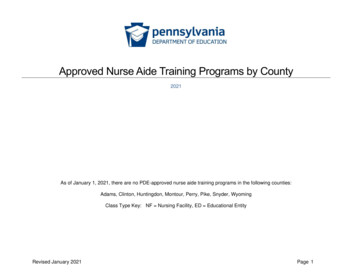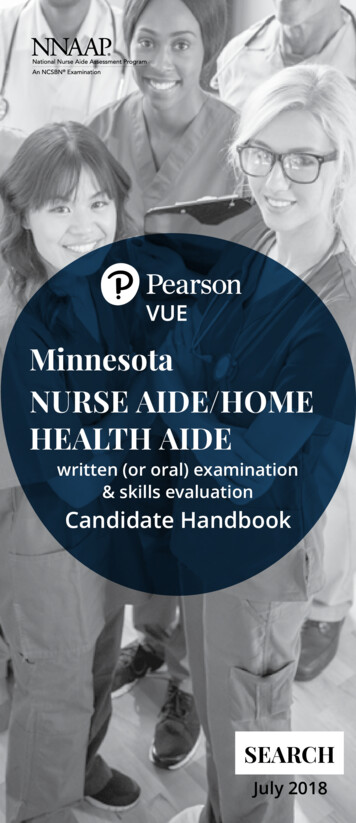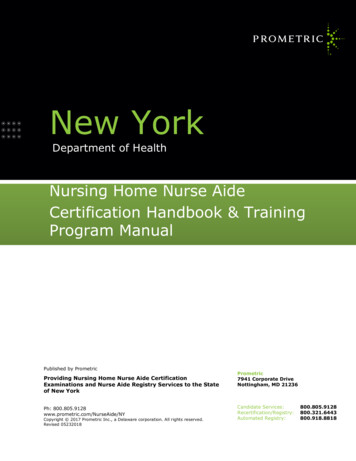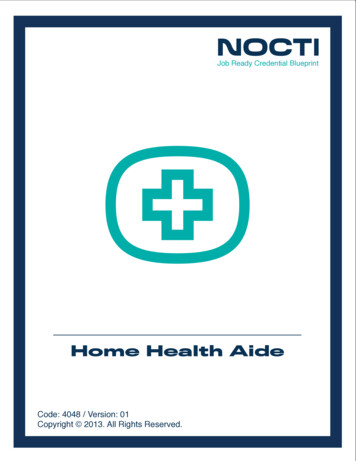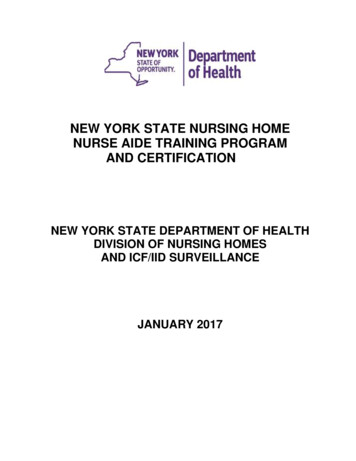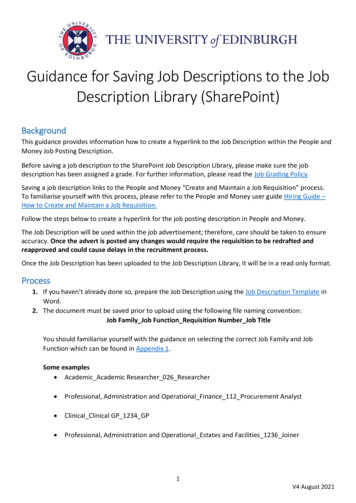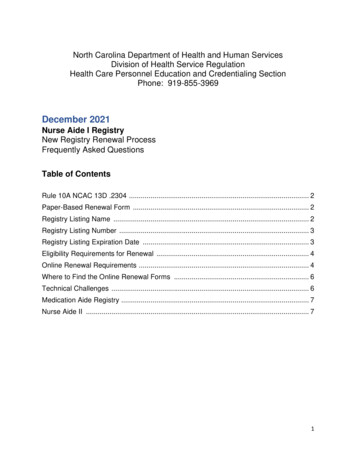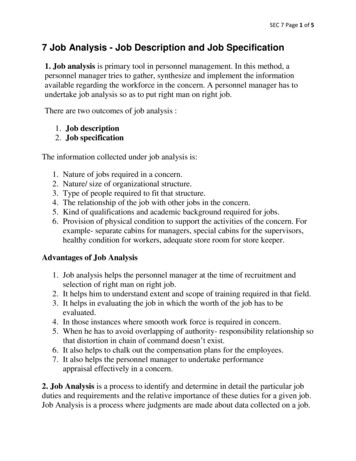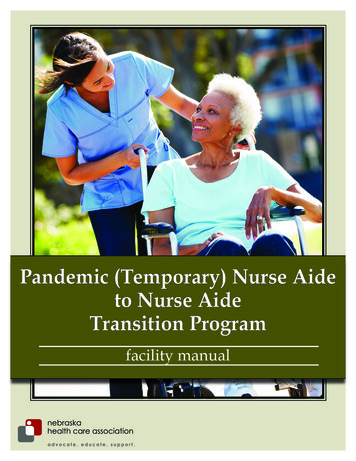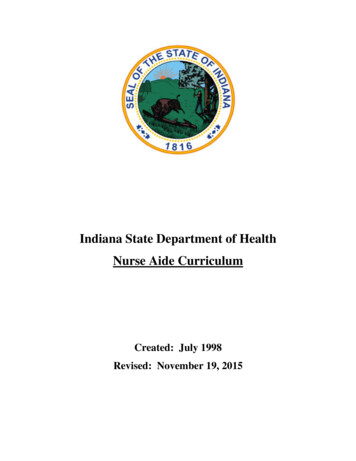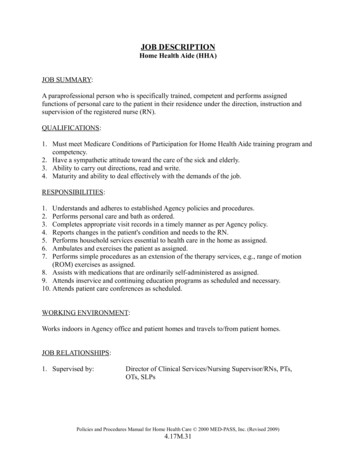
Transcription
JOB DESCRIPTIONHome Health Aide (HHA)JOB SUMMARY:A paraprofessional person who is specifically trained, competent and performs assignedfunctions of personal care to the patient in their residence under the direction, instruction andsupervision of the registered nurse (RN).QUALIFICATIONS:1. Must meet Medicare Conditions of Participation for Home Health Aide training program andcompetency.2. Have a sympathetic attitude toward the care of the sick and elderly.3. Ability to carry out directions, read and write.4. Maturity and ability to deal effectively with the demands of the job.RESPONSIBILITIES:1.2.3.4.5.6.7.Understands and adheres to established Agency policies and procedures.Performs personal care and bath as ordered.Completes appropriate visit records in a timely manner as per Agency policy.Reports changes in the patient's condition and needs to the RN.Performs household services essential to health care in the home as assigned.Ambulates and exercises the patient as assigned.Performs simple procedures as an extension of the therapy services, e.g., range of motion(ROM) exercises as assigned.8. Assists with medications that are ordinarily self-administered as assigned.9. Attends inservice and continuing education programs as scheduled and necessary.10. Attends patient care conferences as scheduled.WORKING ENVIRONMENT:Works indoors in Agency office and patient homes and travels to/from patient homes.JOB RELATIONSHIPS:1. Supervised by:Director of Clinical Services/Nursing Supervisor/RNs, PTs,OTs, SLPsPolicies and Procedures Manual for Home Health Care 2000 MED-PASS, Inc. (Revised 2009)4.17M.31
HOME HEALTH AIDE COMPETENCY TESTName:Date:AHCA Form # 3110-1007, February 20011
Home Health Aide Competency TestWritten ExaminationI.ROLE OF THE HOME HEALTH AIDEAn aide may perform certain duties. Mark the following true or false for tasks you maylegally perform as a home health aide. T True F False1.2.3.4.5.6.7.8.9.10.Reinforce a dressing.Apply a hot pack.Give an enema.Administer medication.Change a sterile dressing.Assist with change of a colostomy bag.Give a rectal suppository.Give a tubal feeding.Give insulin.Cut Nails.CHOOSE ONE CORRECT ANSWER FOR EACH QUESTION BELOW AND CIRCLETHE CORRESPONDING LETTER.11. As a home health aide, you:A.B.C.D.work alone.work as part of the health care team.may become the leader of the health care team.will never get any further training after orientation.12. When you work in the home, you will be:E.F.G.H.responsible for making decisions without any help.working under the supervision of a professional supervisor.away from your office and have no way to contact your employer.responsible for calling the physician with information.13. As home health aide, it is your responsibility to:A.B.C.D.plan the client’s care.do only the tasks that the registered nurse or therapist assigns to you.try to do your best, but not ask for any help.compare assignments with your co-workers.2
II. COMMUNICATIONMark the following true or false. T TrueF False14. In the home, it is important to be a good listener.15. Always tell the patient what you are going to do before starting a procedure.16. You only communicate through words.CHOOSE ONE CORRECT ANSWER FOR EACH QUESTION BELOW AND CIRCLETHE CORRESPONDING LETTER.17. Which of the following is important in communicating with people:A.B.C.D.courtesy.tact.listening.all of the above.18. Body language is:A.B.C.D.a way of communicating feelings by using the body, facial expressions and the eyes.only used by clients to tell their doctors what is causing them problems.only used by persons who are deaf and mute.the newest dance craze.19. Aide care for a conscious patient should be preceded by:A.B.C.D.asking the patient for his permission to go ahead with the procedure.telling the patient you would like to have his cooperation.giving an explanation of what is going to be done.explanation to the patient that the doctor ordered this done.20. Miss Ferris, a home health aide, is assigned to care for Mr. Conway. Miss Ferrisnotices that she feels very angry when she is with Mr. Conway. What should MissFerris do because she feels this way?A.B.C.D.Tell Mr. Conway how she is feeling.Find out if other aides have felt this way.Try to pretend that Mr. Conway is someone she likes.Talk with the agency supervisor about the situation.21. A patient accuses a home health aide of stealing five dollars. The aide has not taken3
the patient’s money, but the patient does not believe this. What should the aide do?A.B.C.D.III.Ask the other aides who care for the patient if they took the five dollars.Ask the patient why the aide is being accused.Offer to give the patient five dollars.Notify the agency supervisor.OBSERVATION, REPORTING AND DOCUMENTATIONMark the following true or false. T TrueF False22. If you do not chart a task that you do for a patient, legally, it was not done.23. If the patient has a new area of skin breakdown, and the nurse is coming in twodays, you do not need to report the skin breakdown to your supervisor.24. A rapid pulse and shortness of breath in a patient usually indicates the patient isexcited and does not need to be reported to the nurse.CHOOSE ONE CORRECT ANSWER FOR EACH QUESTION BELOW AND CIRCLETHE CORRESPONDING LETTER.25. The patient tells you he has not moved his bowels in three days. What should you do?A.B.C.D.Tell him not to worry about it.Tell him to take a laxative.Report it to the nursing supervisor.Pretend you didn’t hear him.26. Which of these actions is the home health aide permitted to take in relation to drugadministration?A.B.C.D.Recording and reporting the patient’s reaction to the medication.Handing out nonprescription medications to the patient who asks for them.Adjusting the dosage of medications given to the patient.Adjusting the times medications are given to fit into the patient’s activities schedule.27. When a patient complains of pain, what should the home health aide do first?A.B.C.D.Ask the patient to describe the pain.Call the patient’s doctor.Offer the patient some warm tea.Change the patient’s position.28. A patient’s prescription for heart pills has recently been changed. The home healthaide should notify the agency supervisor immediately if the patient makes which of4
these comments?A.B.C.D.“The pills are very expensive.”“These pills are different shape from the pills I used to take.”“I have a rash on my stomach since I’ve been taking these pills.”“I can’t take these pills unless I have really cold water to drink.”29. Mrs. Rand, who has diabetes and takes insulin regularly, tells the home health aidethat she feels very nervous and jittery. What should the aide do immediately?A.B.C.D.Take her temperature.Find out when she has her next doctor’s appointment.Have her lie down in bed.Give her a glass of orange juice.IV.READING AND RECORDING TEMPERATURE, PULSE ANDRESPIRATIONSMark the following true or false. T TrueF False30. Always report a pulse rate if the beats per minute are under 60 or over 100.31. The temperature of an unconscious patient should be taken orally since they arenot moving about.32. Recording a patient’s “TPR” or vital signs is not important as long as youremember what they were.CHOOSE ONE CORRECT ANSWER FOR EACH QUESTION BELOW AND CIRCLETHE CORRESPONDING LETTER.33. For which, if any, of these body areas is 99.6 degrees F. a normal temperature?A.B.C.D.Axilla.Mouth.Rectum.None of the above.34. When taking a patient’s pulse, you should take it for:A.B.C.D.15 seconds.one full minute.5 seconds.two minutes.35. When a patient’s respirations are being counted, it is best that the patient:A. tries to breath evenly.5
B. tries to breathe as deeply as he can.C. sits up straight.D. not be aware that the respirations are being counted.V.INFECTION CONTROLMark the following true or false. T TrueF False.36. Hand washing is the single best way to decrease the transfer of pathogens.37. Gloves should be worn when handling items soiled by body fluids.38. The catheter drainage bag must be lower than the bladder, but not on the floor.CHOOSE ONE CORRECT ANSWER FOR EACH QUESTION BELOW AND CIRCLETHE CORRESPONDING LETTER.39. During a visit, you need to wash your hands after removing gloves:A.B.C.D.before you give physical care to the patient.after you pet the dog.before you leave the patient’s home.all of the above.40. In what situation should gloves be used?A.B.C.D.VI.The patient is vomiting.The patient has been incontinent of stool.The patient has drainage wound.All of the above.BODY FUNCTIONS AND CHANGESMark the following true or false. T TrueF False41. Diarrhea can cause dehydration and other serious complications and should bereported.42. If a person complains of pain, it is important to have the patient describe the painand then report it to the nurse and record it in your notes.43. It’s normal for most people to complain of pressure, swelling, or bloating in theirankles, feet, stomach or legs.CHOOSE ONE CORRECT ANSWER FOR EACH QUESTION BELOW AND CIRCLETHE CORRESPONDING LETTER44. If you notice the patient’s catheter is not draining, the first thing you should do is:6
A.B.C.D.call your supervisor.empty the drainage bag.check the tubing to see if it is kinked.do nothing, this is the nurse’s problem.45. Which of the following is not recommended for promoting good daily bowel habits:A.B.C.D.plenty of water.laxatives.exercise.well balanced meals.46. The patient’s pulse has been between 90 and 110 beats per minute since his first aidevisit. Now you find it to be 58 beats per minute. What should you do next?A.B.C.D.Tell the patient he must be getting better.Wait 15 minutes and take the pulse again.Inform the supervisor right away.Just record the pulse in the normal way.47. Mrs. Amos has not had a bowel movement for three days. She has always given herselfan enema if she does not have a bowel movement for that long a time. Mrs. Amos asksthe home health aide to give her an enema. What should the aide do?A.B.C.D.Give Mrs. Amos an enema.Tell Mrs. Amos to wait another day.Suggest that Mrs. Amos take a laxative first.Contact the agency supervisor to discuss the situation.VII. MAINTAINANCE OF A CLEAN, SAFE ENVIRONMENTMark the following true or false. T TrueF False48. A bedside call bell needs to be available so the bed bound patient can summonassistance.49. Bedrails should never be used to secure vest restraints.50. Smoking in bed is fine for anyone who is not confused.CHOOSE ONE CORRECT ANSWER FOR EACH QUESTION BELOW AND CIRCLETHE CORRESPONDING LETTER51. Part of your duties as a home health aide are to assure safe home environment. Thisincludes:A. proper infection control with good hand washing.7
B. electrical and fire safety.C. moving things which may cause the patient to fall.D. all of the above.52. A patient is receiving oxygen through a nasal cannula. What safety precautions shouldthe home health aide take?A.B.C.D.Keep the television set at least 5 feet from the oxygen tank.Do not permit the patient to drink soda.Allow no smoking in the patient’s room.Do not use any lotions that contain oil in the patient’s room.VIII. EMERGENCY PROCEDURESMark the following true or false. T TrueF False53. For an injury with profuse bleeding, apply pressure and call for assistance.54. If the patient begins to have a seizure, your first responsibility is to prevent thepatient from injuring himself.55. If the patient falls and complains of pain in his hip, you should help him to get upand walk to the bed.CHOOSE ONE CORRECT ANSWER FOR EACH QUESTION BELOW AND CIRCLETHE CORRESPONDING LETTER.56. A patient is choking on some object that is caught in his airway. Before first-aidmeasures are applied, find out:A.B.C.D.if the patient’s pulse rate is over 80.if the patient can swallow clear fluids.if the patient can speak or cough.What medications the patient has taken in the past 24 hours.57. While giving a bath on a shower chair, the patient suddenly gasps and becomesunresponsive. The home health aide should:A. call for family assistance and continue with the bath.B. leave the patient and call 911.C. lower the patient to the floor, call for the family to call 911, determine if CPR is neededand initiate it if indicated.D. tell the family to stay with the patient while you call 911 and the supervisor.8
58. For which of these emergencies is a knowledge of pressure points essential?A.B.C.D.Health stroke.Burns.Food poisoning.Bleeding.59. The telephone numbers of all of the following are important to a patient. Whichnumber must the home health aide have next to the telephone?A.B.C.D.IX.The patient’s clergyman.The drugstore.The emergency medical squad.The next-door neighbor.HUMAN DEVELOPMENTMark the following true or false. T TrueF False60. Every patient is the same and has the same needs and wants.61. It is all right to use any item in the home without asking as long as it is for thepatient’s personal care.62. You may use the telephone in the patient’s home without asking permission.CHOOSE ONE CORRECT ANSWER FOR EACH QUESTION BELOW AND CIRCLETHE CORRESPONDING LETTER.63. A neighbor has asked you some questions about the patient you are presently takingcare of. “Mrs. Collier is dying, isn’t she?” How will you answer her?A.B.C.D.“Mrs. Collier is doing as well as can be expected.”“I am sorry, but I cannot discuss Mrs. Collier.”“Yes, it’s too bad, but she’s very ill.”“How did you know about Mrs. Collier and her illness?”64. Which of these statements about the elderly is true?A.B.C.D.They cannot change.They can learn new things.They want to become dependent on others.They do not enjoy meeting new people.65. When working with person who are disabled, the general goal of care is to:9
A. provide constant supervision.B. provide total care.D. promote maximum self-care and independence within the limits of the person’sability.D. promote the complete return of the person’s abilities.66. It is Mrs. Amos’s usual time for lunch, but she says she is not hungry yet. This is thefirst time that Mrs. Amos has made this type of statement. What should the homehealth aide do?A. Insist that Mrs. Amos eat at this time.B. Tell Mrs. Amos to let the aide know when she wants to eat, and remind her that it isimportant that she have lunch.C. Tell Mrs. Amos that if she does not eat by herself, she will have to be fed.D. Tell Mrs. Amos that it took a lot to time to prepare the food and that she should eatit while it is fresh.67. The ability to make observations is even more important when working with infantsand young children than it is when working with adults. The chief reason for this isthat infants and young children:A.B.C.D.X.do not like to be told what to do.are usually sicker than adults.enjoy human contact more than adults.cannot explain how they feel.PERSONAL CAREMark the following true or false. T TrueF False68. It is important to keep a patient covered during a bedbath except for the partbeing washed.69. Massaging of bony prominences helps to prevent skin breakdown by increasingthe blood supply to the area.70. When giving peri-care to a patient after a BM, wash using a front to back motionin order not to spread fecal material to other areas.CHOOSE ONE CORRECT ANSWER FOR EACH QUESTION BELOW AND CIRCLETHE CORRESPONDING LETTER.71. Which of the following is most appropriate practice to promote good skin care in theelderly:A.B.C.D.keep the skin clean and well moisturized.apply alcohol to bare areas of the skin.wash daily with scented soaps.all of the above.10
72. If dentures are not worn when sleeping, where should you store them?A.B.C.D.Wrap in a washcloth.Put in a sterile container.Wrap in a guaze pad.Place in a clean container in clean water.73. Why is it important that a patient have good mouth care?A.B.C.D.Bacteria in the mouth can cause tooth decay and gum infections.The saliva in the mouth is the source of stomach juices.Poor oral hygiene causes more saliva to be made.Poor oral hygiene interferes with the sense of smell.74. An elderly male patient occasionally wets his trousers. What should the home healthaide do?A.B.C.D.Give him fluids with his meals only.Avoid giving his coffee and tea.Tell him if he urinates on himself he will have to be put in diapers.Encourage him to go to the bathroom at least every two hours.75. In giving foot care to a patient who has diabetes, the home health aide may take whichof these actions?A.B.C.D.XI.Clean under the toenails.Cut the toenails.Soak the patient’s feet for more than 5 minutes in a basin of warm water.Put lotion on the patient’s feet after drying them.SAFE TRANSFER TECHNIQUES AND AMBULATIONMark the following true or false. T TrueF False76. Always transfer a patient towards his good side.77. There is no need to be near an object to pick it up, just reach.78. It’s best to use a gait belt if a patient is unsteady.CHOOSE ONE CORRECT ANSWER FOR EACH QUESTION BELOW AND CIRCLETHE CORRESPONDING LETTER.11
79. A patient lying on his back has slid down in bed and needs help in moving up again.To start this, the patient should, if possible:A.B.C.D.raise himself on his elbows.separate his legs widely.arch his back.flex his knees and push with his heels.80. Before helping a patient into or out of a wheelchair, which of these actions arenecessary?A.B.C.D.Have the brakes unlocked and leave the foot pieces down.Lock the brakes and fold the foot pieces up.Have the brake unlocked and the foot pieces up.Lock the brakes and leave the foot pieces down.81. When assisting a patient to walk with his walker, you should:A.B.C.D.clear a pathway and remove all safety hazards.stay close to the patient’s side.stand on the other side of the room.A and B.82. A patient who has been on bed rest is to get up in a chair. The home health aide helpsthe patient to sit on the edge of the bed. The patient says, “I am dizzy.” What shouldthe aide do?A.B.C.D.Rub the patient’s feet.Help the patient to a standing position and see if the dizziness goes away.Put a cool compress on the patient’s head.Support the patient in a sitting position and wait a minute or so to see if the dizzinessgoes away.83. Patient has had a stroke and has a right-sided weakness. The patient can walk with alittle assistance. It is best for the home health aide to assist the patient by walking inwhich of these positions?A.B.C.D.Directly in front of the patient.Directly in back of the patient.On the patient’s left side.On the patient’s right side.84. Mr. Stone is 76 years old, needs help with bathing, and has a foley catheter in place.He has great difficulty walking and uses a wheelchair. When helping Mr. Stone from12
the bed to the wheelchair, which of these actions is essential.A.B.C.D.Place the foot supports of the wheelchair so that he can step up on them.Have a blanket draped in the wheelchair.Have the brakes on the wheelchair in a locked position.Place a pillow on the seat of the wheelchair.XII. NORMAL RANGE OF MOTIONMark the following true or false. T TrueF False85. Passive range of motion exercises are for the prevention of contractures inpatients with paralyzed limbs.86. During range of motion exercises, if you feel resistance or the patient complainsof pain, you should continue anyway.87. It’s best to have a pillow between the legs of a patient with a new hipreplacement.CHOOSE ONE CORRECT ANSWER FOR EACH QUESTION BELOW AND CIRCLETHE CORRESPONDING LETTER.88. To prevent bedsores in the elderly, you should:A.B.C.D.change the patient’s position every two hours if they are unable to do so themselves.get the patient out of bed if they are allowed to do so.ensure adequate nutrition with special emphasis on protein intake.all of the above.89. The home health aide should be sure to take which of these actions when caring for anewborn baby?A.B.C.D.Support the baby’s head and neck when picking the baby up.Clean the inside of the baby’s ears with cotton swabs.Use petroleum jelly to keep the area around the baby’s naval moist.Hold the baby only at feeding and bathing times.90. Which of these statements describes good body mechanics?A. Carry heavy objects as far away from the body as possible.B. Bend the knees when lifting an object off the floor.13
C. Bend over at the waist when lifting an object from the floor.D. Lift rather than push a heavy object.91. When caring for a patient who is on bed rest, what should the aide do to preventbedsores?A.B.C.D.Keep the top sheets well tucked in.Keep the bottom sheet free of wrinkles.Use only sheets that are 100% cotton on the patient’s bed.Use only woolen blankets to cover the patient.92. Physical therapy has started range of motion exercise. Which of these statementsabout exercise is true?A. If a patient cannot talk, do not explain the exercises to the patient.B. During exercise, all joints should be moved in all directions.C. When the patient does not assist when the joint is moved through its range ofmotion, the exercise is called active exercise.D. It is important to support the body parts above and below the joints when they aremoved during exercises.XIII. NUTRITIONMark the following true or false. T TrueF False93. Soy sauce is good to spice up a low salt diet.94. A regular diet is a well balanced diet with no restrictions.95. Bread and potatoes are a good source of protein.CHOOSE ONE CORRECT ANSWER FOR EACH QUESTION BELOW AND CIRCLETHE CORRESPONDING LETTER.96. Foods on a liquid diet would include:A.B.C.D.chicken, eggs and toast.chopped and strained foods.broth, tea and jello.lightly seasoned foods.97. Foods that are high in vitamin C include:A. oranges, tomatoes and watermelon.14
B. potatoes, raisins and bananas.C. liver, beef and chicken.D, cheese, milk and cottage cheese.98. If there is 50cc left in glass and the glass holds 150cc you should record the intake as:A.B.C.D.90cc.120cc.100cc.50cc.99. Which of these fluids if highest in protein?A.B.C.D.Vegetable broth.Lemonade.Tomato juice.Eggnog.100. Milk is a good source of calcium. Which of these foods is also high in calcium?A.B.C.D.Cheese.Bananas.Orange juice.Raisins.101. When patients do not have enough fluids, they may develop which of these ndruff102. If a patient is to have a fluid intake record kept, the right time to record thepatient’s fluid is:A.B.C.D.when the fluids are served to the patient.when the patient has drank the fluids.every 2 hours.after each meal.103. Patient on low salt diets are usually allowed to have which of these foods?A.B.C.D.Hard cheeses.Canned soups.Raisins.Olives.15
XIV. CULTURAL DIFFERNCES IN FAMILIESCHOOSE ONE CORRECT ANSWER FOR EACH QUESTION BELOW AND CIRCLETHE CORRESPONDING LETTER.104. Patients sometimes express religious beliefs with which the home health aide doesnot agree. In dealing with these situations, which of these understandings should theaide use as a guide?A.B.C.D.Patients have a right to their own beliefs, which should be respected.Patients should be told not to discuss their beliefs with aides.Aides should explain their beliefs to patients.Aides should pretend to have the same beliefs that patients have.
HOME HEALTH AIDE COMPETENCY EVALUATIONWRITTEN EXAMINATIONANSWER SHEETI. ROLE OF THE HOME HEALTH AIDETrue or False1. TRUE2. FALSE3. FALSE4. FALSE5. FALSE6. TRUE7. FALSE8. FALSE9. FALSE10. FALSEQuestions11. B12. B13. BII. COMMUNICATIONTrue or False14. TRUE15. TRUE16. FALSEQuestions17. D18. A19. C20. D21. DIII. OBSERVATION, REPORTING AND DOCUMENTATIONTrue or False22. TRUE23. FALSE24. FALSEQuestions25. C26. A18
27. A28. C29. DIV. READING AND RECORDING TEMPERATURE, PULSE AND RESPIRATIONSTrue or False30. TRUE31. FALSE32. FALSEQuestions33. C34. B35. DV. INFECTION CONTROLTrue or False36. TRUE37. TRUE38. TRUEQuestions39. D40. DVI. BODY FUNCTION AND CHANGESTrue or False41. TRUE42. TRUE43. FALSEQuestions44. C45. B46. C47. DVII. MAINTENANCE OF A CLEAN, SAFE ENVIRONMENTTrue or False48. TRUE49. TRUE50. FALSE19
Questions51. D52. CVIII. EMERGENCY PROCEDURESTrue or False53. TRUE54. TRUE55. FALSEQuestions56. C57. C58. D59. CIX. HUMAN DEVELOPMENTTrue or False60. FALSE61. FALSE62. FALSEQuestions63. B64. B65. C66. B67. DX. PERSONAL CARETrue or False68. TRUE69. TRUE70. TRUEQuestions71. A72. D73. A74. D75. C or DXI. SAFE TRANSFER TECHNIQUES AND AMBULATIONTrue or False20
76. TRUE77. FALSE78. TRUEQuestions79. D80. B81. D82. D83. D84. CXII. NORMAL RANGE OF MOTIONTrue or False85. TRUE86. FALSE87. TRUEQuestions88. D89. A90. B91. B92. DXIII. NUTRITIONTrue or False93. FALSE94. TRUE95. FALSEQuestions96. C97. A98. C99. D100. A101. C102. B103. CXIV. CULTURAL DIFFERENCES IN FAMILIESQuestion104. A21
Job Description – Home Health Aide (HHA) continuedRISK EXPOSURE:High riskLIFTING REQUIREMENTS:Ability to perform the following tasks if necessary: Ability to participate in physical activity. Ability to work for extended period of time while standing and being involved in physicalactivity. Heavy lifting. Ability to do extensive bending, lifting and standing on a regular basis.I have read the above job description and fully understand the conditions set forth therein, and ifemployed as a Home Health Aide, I will perform these duties to the best of my knowledge andability.DateSignaturePolicies and Procedures Manual for Home Health Care 2000 MED-PASS, Inc. (Revised 2009)4.17M.32
20. Miss Ferris, a home health aide, is assigned to care for Mr. Conway. Miss Ferris notices that she feels very angry when she is with Mr. Conway. What should Miss Ferris do because she feels this way? A. Tell Mr. Conway how she is feeling. B. Find out if other aides have felt this way. C. Try to pretend that Mr. Conway is someone she likes.
